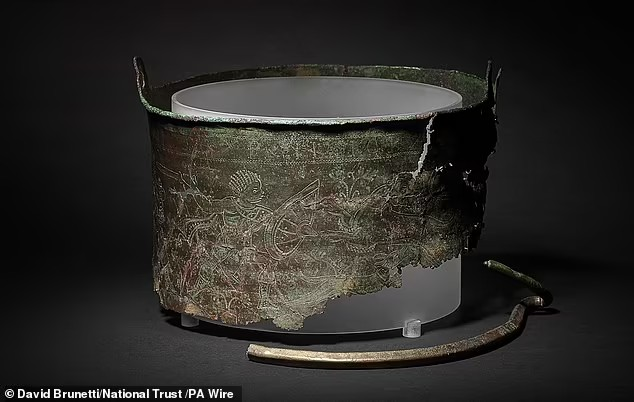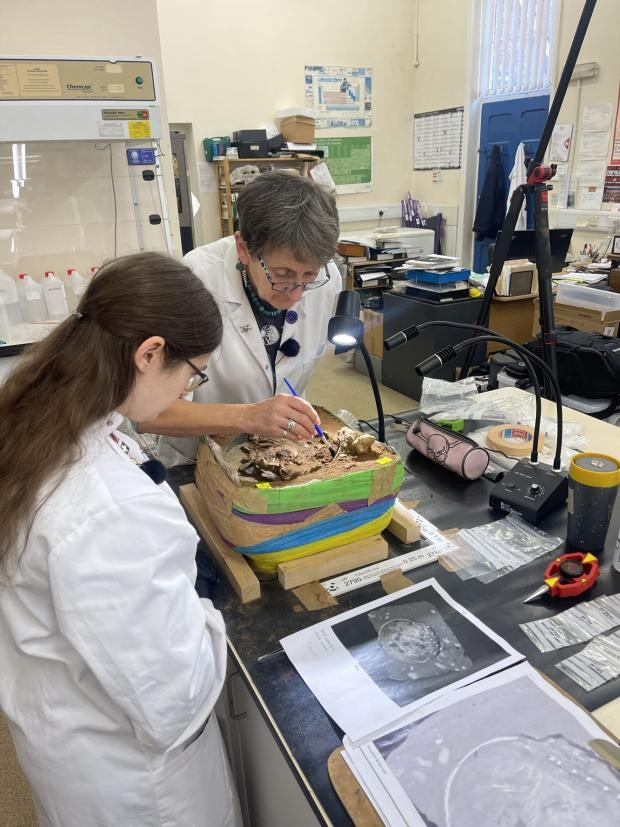One of the most captivating archaeological puzzles at Sutton Hoo has finally been unraveled—the mystery of the Byzantine bucket inscribed in Greek.
After decades of speculation, researchers have determined that this silver vessel—unearthed in fragments at Sutton Hoo in 1986 and expanded upon in 2012—was in fact a cremation urn. It held the ashes of a “significant individual” who was buried generations before the famous ship burial that made the site legendary.
Now proudly on display in Sutton Hoo’s main exhibition hall, the 1,400-year-old vessel reveals new secrets thanks to a string of groundbreaking discoveries. During the final week of filming for the 2024 season of Time Team—in collaboration with FAS Heritage and England’s National Trust—archaeologists recovered additional fragments, including a fully intact base. The find included not only cremated remains but also grave goods, offering unprecedented insight into early Anglo-Saxon funerary practices.
Sir Tony Robinson, long-time presenter of Time Team, ranked the vessel as his third favorite discovery in the show’s history. Following the discovery, the entire vessel was moved to a lab for detailed analysis.
At the University of Bradford, CT scans and X-rays revealed the contents of the vessel’s base, which had remained a mystery until then. With support from Time Team Patreon backers, the base underwent a careful micro-excavation at the York Archaeological Trust.
According to Angus Wainwright, an archaeologist from the Trust, the vessel is not only a rare and valuable artifact from Anglo-Saxon England, but also “a long-standing enigma” due to the unknown reason for its burial. “We now know that it contained the remains of a prominent individual from the Sutton Hoo community. With further analysis, we hope to uncover even more about this unique burial.”
While archaeologists have yet to confirm the individual’s sex based on the limited skeletal remains, a partially burned comb found inside the vessel may hold the key. If DNA can be extracted from the comb—likely made from deer antler—it could reveal both the gender and age of the person cremated, as well as more details about the cremation process and funeral pyre construction.
The Treasures of Sutton Hoo
Excavations at Sutton Hoo will continue until June.
Photo: James Dobson/National Trust.
The vessel’s base contained human remains along with animal bones, believed to be from a creature larger than a pig—possibly a horse. Including such animals in cremation pyres was common in early Anglo-Saxon rituals and signified high status.
Further recent finds from the site include intricately carved decorations featuring human and animal legs, shield bosses, and the face of a man. Regardless of the individual whose remains lie in the Bromeswell Bucket—as the vessel has been dubbed—it remains a remarkable testament to the metalworking skills of the Anglo-Saxons.
Interestingly, the vessel’s base features concentric rings, and CT imaging confirmed it was crafted using cold-hammering—a technique that shapes metal through pressure, not heat. Despite its age, the artifact is in remarkably good condition.
The vessel itself was likely created in the Byzantine Empire during the mid-6th century, predating Sutton Hoo’s ship burial by several decades. It probably originated in the eastern Mediterranean and was brought to England through trade or diplomatic channels, highlighting Sutton Hoo’s far-reaching connections.
The famous Sutton Hoo ship burial, which dates between 610 and 635 CE, occurred during the Anglo-Saxon kingdom of East Anglia’s rule. Before the site’s visitor center was established in 2000, earlier excavations had uncovered 6th-century graves. The new cremation discoveries confirm that the burial grounds extend into the nearby Garden Field.
Dr. Helen Geake, an Anglo-Saxon expert working with Time Team, commented: “We’ve finally solved the puzzle of the Bromeswell Bucket—it turns out to be the earliest known use of such a rare object in a cremation burial. It’s the epitome of the wonderfully strange nature of Sutton Hoo—a place with ship burials, horse burials, burial mounds, and now, even bath bucket burials. Who knows what else is hidden beneath?”
Looking Ahead
Tim Taylor, the show’s producer, expressed excitement over returning to one of Britain’s most iconic sites. “We’re thrilled to be back at Sutton Hoo with the National Trust. The next phase of excavations offers a unique chance to uncover more of this site’s secrets. We can’t wait to see what 2025 holds.”
A Glimpse Into Sutton Hoo’s Past
Laboratory analysis of the findings.
Photo: FAS/National Trust.
Located in Suffolk, England, Sutton Hoo is a 1,400-year-old archaeological site renowned for its wealth of Anglo-Saxon treasures. The site first came to prominence in 1939, when local landowner Edith Pretty invited amateur archaeologist Basil Brown to investigate several burial mounds on her property.
What Brown uncovered would become one of the greatest archaeological discoveries in British history: a 21-meter-long ship burial containing a treasure-laden burial chamber. Although the ship’s wooden structure had decayed in the acidic soil over the centuries, its outline remained, along with phosphate traces indicating a once-present human body.
Of the 20 known burial mounds at Sutton Hoo, the most famous is the ship burial, believed to contain the remains of a man—perhaps a king—accompanied by extraordinary grave goods. Among them: an ornate helmet, gold coins, and a finely forged iron sword.
Sutton Hoo remains an active archaeological site, drawing daily visitors and scholars from around the world. The individuals buried there left no written records, but historians believe the cemetery was used by the Wuffingas—the royal dynasty of East Anglia. It’s widely speculated that the ship burial may belong to Rædwald, an early East Anglian king.
Justin Garner-Lahire, director of the FAS Heritage archaeological service, at one of the burial pits in the Garden Field at Sutton Hoo.
One Discovery at a Time
As excavations continue into June, each find deepens our understanding of early medieval Britain. The Sutton Hoo site, with its layers of history and mystery, remains a national treasure—reminding us that even the most unassuming objects, like a Byzantine bath bucket, can hold incredible stories of the past.










